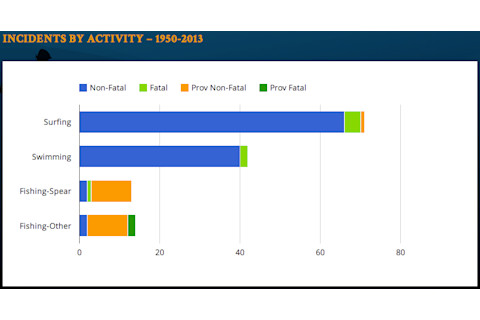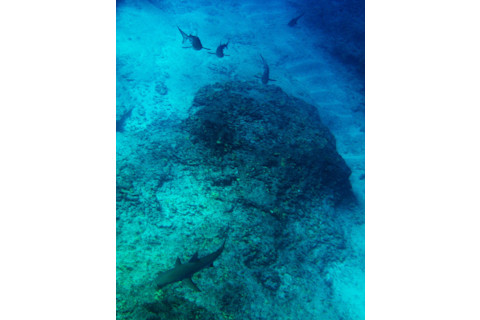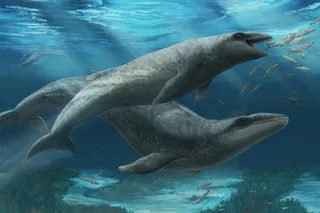Thursday night, I sat down with more than 15 scientists to watch Shark Week. Most of them don't watch the annual spectacle—they've become embittered after years of Discovery's fear mongering, mockumentaries, and lies. But this particular episode was different—it was all about our home, Hawaii. We all wondered how the sharks that roam our islands' waters would be portrayed, and we joked about how many times we'd hear ominous music or see blood in the water. We wouldn't have been so jovial if we knew what was in store. I would argue that Sharkageddon is the worst Shark Week special this year, perhaps even to date. At least with the mockumentaries, there was the expectation that the audience would understand they were fake, even if that expectation was wildly off. Megalodon and Shark of Darkness carry disclaimers saying that the events were dramatized and that there is "debate". Sharkageddon, on the other hand, is billed as truth. It pretends to lay out the facts and be a documentary. And it isn't. Almost everything said in the hour-long program is wrong. I won't go into how the shark "danger scale" is ridiculous at best (cookie cutter sharks a "5"? Not unless that's the lowest number!). I'm even going to gloss over the poor reenactments full of threatening music that make it look like sharks magically sneak up on their victims in crystal clear water (hint: that's not what it looks like during shark attacks). Instead, I'm going to focus on false statements that were delivered as if they were cold, hard facts, and how Discovery used shady filming tactics to try and convince the world that Hawaii is in the midst of a Sharkageddon.
FACT: There is no evidence that shark attacks in Hawaii are on the rise.
Let's start with the premise. The program is based on the notion that shark attacks in Hawaii are increasing; a "sharkageddon", as they define it. The entire show is based on this notion—trouble is, there's no evidence for it. Period.

It's not ok to distort your axis, Discovery. That's unethical. Look closely at the graph Discovery places near the beginning of the episode. The gridlines aren't consistent, such that the distance between 1 and 10 is only half the distance between 10 and 20. This is data distortion 101—a clear attempt to skew the data visually to make you think shark attacks are increasing more than they actually are. And that's even if the data were accurate, which they're not. I'm not sure where they got their shark attack numbers from, but the Division of Aquatic Resources in Hawaii has more than 20 years worth of shark attack data freely available on their website. There were 14 unprovoked shark attacks in 2013 and 10 in 2012. Note: even Discovery's map only has 12 shark bite points on it. While the number of attacks was higher than in other years, the simple fact is shark attacks vary greatly from year to year. Here's the real graph of shark attacks by year over the past decade:

There's no increasing trend in the past decade. A couple high years don't mean shark attacks are increasing statistically! If Discovery had dared to run some statistics, they would have found that there's no mathematical support for the supposed increase. A Mann-Kendall trend analysis of the data from 1993-2014 finds no trend despite the high numbers in 2012 and 2013. To be fair, the notion that shark attacks are increasing isn't out of the question. Right now, we are unable to detect a positive trend given the data. Maybe in years to come, that will change. But so far this year, attacks are down—in 2014 there has been one shark attack. It's not looking like the 'trend' is continuing. But even if there is an increase, the various hypotheses (not "theories"—theories are well substantiated explanations) presented in the show are complete crap. What were those hypotheses?
"Recent and unusual influx of great whites to the area"
"Huge increase in these sea turtles right now because they have been protected."
"Sharks are becoming conditioned to the sound of spearfishermen, especially the snap of the gun"
"Hawaii's unique geology that brings deep water sharks near the shore."
"Repeat offenders"
"The sharks of Kahoolawe are coming to Maui to feed."
At least they have the courtesy to dismiss #1 off the bat, noting that white sharks were not suspected in any of the attacks. They go on to test the others with "experiments" performed by local "experts". But everything, from the supposed experts to the experiments conducted, is not as it seems. I'll address each of these hypotheses as they appear in the show (the last two together, since they focus on the same species and general science).
FACT: There is no connection between turtle populations and shark attack statistics.
"Shark expert" Photographer and surfer Juan Oliphant proposes to Kala Alexander—surfer on a mission for truth—that protections on green sea turtles in Hawaii are to blame for increased tiger shark attacks. The hypothesis, as it was stated in Sharkageddon:
"One possible conclusion lies in the population of Hawaiian green sea turtles. In 1978, they were added to the Endangered Species Act, and since then, their numbers have increased dramatically. This turtle buffet attracts more sharks to the shores where turtles feed, and more run-ins with humans at the water's surface"
The notion surfaced last year when Rep. Joe Souki placed the blame for shark attacks on turtles in a news piece. "What we need to do is to lift the ban on turtles as a protected species, and maybe it could start with the Native Hawaiians as they do in Alaska where they allow the natives to go and hunt the whales during the whale season," said Souki in an interview with Hawaii News Now. Scientists were quick to respond. "The timelines of the turtle recovery and this increase in incidents, those timelines don't match," said researcher Kim Holland of the Hawaii Institute of Marine Biology in the same article. He's right—sea turtle populations have increased steadily since 1980, while shark attacks have only "spiked" in the past two years. If the two variables were related, you would expect to see steady shark increases, too, not a random jump. Holland also pointed out that turtles aren't the main prey of tiger sharks. In fact, they only make up ~5% of the sharks' diet. Around 70% of their diet is fish. So what of that dramatic scene in Sharkageddon of the tiger shark choosing the turtle over Oliphant? Look a little closer.

See the dead fish? Look at the hind flippers.

There it is! A clear fish tail attached to the fin. While it was billed as the shark choosing between a man and a turtle, in reality, it was at best between man and dead fish. That's some seriously dishonest filming tactics, even for Discovery.And what a surprise? The shark bites right where the fish are attached. You can even see a piece of fish falling off in this shot:

A chunk of fish falls as the tiger bites. It wasn't a "strategic bite"—it was where the food was hiding. And what about when the shark comes back to "finish it off"? Watch it again. It just takes the attached fish and leaves.
"Styrofoam turtles are not the tiger shark's natural prey" #Sharkageddon#FactCheckSharkWeek — Christie Wilcox (@NerdyChristie) August 15, 2014
Alexander was right about one thing, though: "When it had a choice between its normal prey and you, it went for its normal prey." It just wasn't a turtle dummy that it went for, but rather the chum Discovery attached to it. This test doesn't "prove that it's a case of mistaken identity," and it certainly doesn't answer any questions about why sharks are attacking surfers (unless surfers have started lashing dead fish to their feet—which I don't recommend). What it does do, however, is perpetuate the myth that turtle abundance is linked to shark attack increases, a myth that is being used to attack sea turtle conservation efforts that are still very much needed. Don't blame the turtles. Even if attacks on surfers do occur because of mistaken identity—like is presumed with great whites and surfers off the California coast—there's no connection between attack frequencies and turtle populations, and culling turtles isn't going to protect surfers from future attacks. While we're at it: you can't say that tiger sharks actively pursue turtles and in the same segment call them "indiscriminate feeding machines." Do they specifically hunt turtles? Or are they indiscriminate?

And if they're indiscriminate, why don't they bite the watermelon? Of course, tiger sharks aren't indiscriminate. They eat a diversity of prey, but they don't simply eat "anything".
FACT: Spearfishing accounts for less than 10% of shark attacks in Hawaii, and those attacks are recorded.
Alexander next talks to Michael Jutt, a spearfisherman from Maui. Jutt claims that though there have been "a lot of attacks", with "a lot of them end up going unreported." Why wouldn't a shark attack be reported? "Because they are considered provoked attacks." "Even if I was out today and shot this fish and a shark attacked me, it wouldn't have been reported," he said to Alexander. Jutt's only half right. It is true that spearfishing and fishing related attacks are often (though not always) considered "provoked" attacks, which means they don't factor into certain statistics. But that doesn't mean they're not reported. The only way an attack goes unreported is if the person attacked doesn't report it. On the DAR website, you can see a graph of shark attack by activity type for all attacks since 1950, including provoked ones. The orange and dark green bars represent those provoked attacks. Provoked attacks make up a small portion of the total attacks, and overall, spearfishing related attacks are less than ten percent of the total attacks in Hawaii.

If spearfishing attacks "don't go on record", then why does DAR have these records? The numbers: 14 fishing, 13 spearfishing, 42 swimming, 71 surfing. It is possible that spearfishermen aren't reporting their interactions with sharks, but if that's true, that's on them. Clearly, some spearfishermen have reported shark attacks, or DAR wouldn't have these numbers to begin with. But perhaps more importantly, if the spearfishing attacks that have occurred recently "weren't reported" (as Jutt claims) then why is Alexander looking into them as the source of the "spike" in attacks? The "spike" is in reported attacks. Meanwhile, to prove some kind of point, Jutt and Alexander go off in search of sharks that will come to the smell of blood in the water—I mean, the sound of a speargun. Jutt manages to shoot two fish, and the pair seem surprised when a few (looks like 5? Maybe 6?) Galapagos sharks arrive on the scene. "We have to get out of here, Mike!" Alexander tells Jutt. Of all the sharks that Sharkageddon focuses on, I'm most familiar with the Galapagos. And yes, they will say a friendly hello if you are spearfishing in an area where they're found. But there's no reason those sharks should have scared Alexander and Jutt out of the water. I would know—I've been in their position.
A galapagos shark arrives "a more deadly shark". I've dove w lots of them. While spearing. #justsaying#Sharkageddonpic.twitter.com/qpE51wtFvV — Christie Wilcox (@NerdyChristie) August 15, 2014

Shot from the safety stop at 15', where ascent allowed me to get the most sharks in frame. We were surrounded by about fifteen sharks at one point during the dive. But more to the point, Discovery concludes that because a few Galapagos sharks showed up when fish were speared, this "proved that sharks are becoming conditioned to the sound of spearfishermen, especially the snap of the gun." Then they go even further. "But there's a more terrifying prospect: these sharks may also be associating the expelling of bubbles and the kicking of fins as a sign food is near." Come again, Discovery? The "test" in no way examined whether sharks are attracted to the sounds of spearguns, scuba or freediving activity. To test that, you'd want to see if they show up and act aggressive when there aren't bleeding animals around. In this case, the sharks reacted to one thing: dying fish. Or, in their minds, food. There's no evidence that they associated any other aspect of the situation with that food. Sharkageddon is spreading a dangerous message by saying that sharks are learning to associate water activities with mealtime. Not only is there no evidence that sharks are conditioned to associate food with the sounds of diving, there's more evidence to the contrary. Divers are almost never harassed by sharks. I cannot even count the number of sharks I have seen on dives, even while spearfishing, and I have never been attacked. But perhaps images speak louder than words: if Galapagos are so terrifying, then why weren't divers on a research cruise in the Papahanaumokuakea Marine National Monument afraid of this many Galapagos sharks?

Up in the Northwest Hawaiian Islands, divers regularly encounter schools of hundreds of Galapagos sharks.
FACT: You have nothing, and I mean nothing, to fear from a cookie cutter shark.
"The next case in Hawaii's Sharkageddon" is a bizarre one. "An unprovoked night attack," the narrator describes, "from a rare and unusual shark." Sharkageddon then goes onto describe the attack of Mike Spaulding, who was bitten by a cookie cutter shark ten miles from the coast while attempting the open ocean swim between the big island and Maui. Sharkageddon very quickly glazes over the fact that this particular attack is the only bite that has ever occurred from a cookie cutter shark. And it isn't a part of the supposed "Sharkageddon"—Spaulding was bitten in 2009, four years before the "spike" in attacks. Discovery isn't unaware of this detail; they are careful to list the date on the reenactment correctly. Yet, the show implies this bite is related to the "increase" in shark attacks, and Alexander brings in marine biologist Jeff Milisen to track down "deep water killers." Your biggest threat, according to Sharkageddon? "The cookie cutter shark—the piranha of the open ocean." Seriously?

This is not a "piranha". Image from Wikipedia. I'll admit that cookie cutter jaws are a little nightmare-inducing up close. But these sharks are most definitely not piranha-like in any way. Theodore Roosevelt once called the piranha "the most ferocious fish in the world." Piranha's swarm and feed in a frenzy, while cookie cutters are solitary fish which take single bites out of large prey. You're never going to get attacked by several hundred cookie cutter sharks at once and torn to shreds. You're probably never going to get attacked by a single cookie cutter shark, no matter how much night swimming you do. I can say that because Discovery pointed out the only person in all of recorded history who ever has been bitten by one. Ever. EVER. But Milisen and Alexander dove down anyway searching for one, and while protected by a cage (Really? How exactly would the cage keep out a fish that's less than a foot long?), the two spotted their first animal—a hydrozoan. Which, by the way, is not "a fancy term for jellyfish." Jellyfish are in the class Scyphozoa, while hydrozoans—not including the salps spotted by the divers (which are an entirely different phylum!)—are class Hydrozoa. I know it's a little detail, but it's exactly the kind of fact that Discovery shouldn't let slip through. Then the divers saw other sharks—a tiger, a great hammerhead, and an oceanic white tip. Which lead to the new hypothesis: "Kala realizes that it's Hawaii's unique geology that brings deep water sharks near the shore." There are plenty of deep water sharks in the world, few of which have ever attacked a human being. While Sharkageddon makes them sound like man-eaters, the stunning diversity of deep water sharks was beautifully revealed in Alien Sharks 2: Return to the Abyss, which aired on Tuesday night. The special was rare form for Shark Week in that it accurately portrayed shark science without 'near-death' shark encounters or "dramatization". Fear mongering aside, it would have been really cool to see some deep water sharks in Sharkaggedon. Unfortunately, none of the sharks seen by the divers were "deep water" sharks. Perhaps the production crew simply confused "deep water" with pelagic or open ocean sharks. In that case, the oceanic white tip is a pelagic shark, and tiger sharks are known to cruise large stretches of open ocean. Hammerheads, though, are semi-pelagic at best, and preferring coastal areas. There's nothing unique about Hawaii's coastline that draws these sharks in. Steep drops in depth are found in many places around the world—the coast of California, for example. And if it was geology, how would that explain a recent increase? How exactly has Hawaii's geology changed in the past five years? And if it were pelagic sharks to blame, you'd expect there to have been attacks from the most notorious of the bunch: the great white shark. The geologic hypothesis simply doesn't make sense.
FACT: Tiger shark movement patterns are messy.
Jeff Milisen isn't studying tiger shark movements in Hawaii. Milisen is a technician for Kampachi Farms, an innovative aquaculture business based on the big island. According to his LinkedIn, he is "currently working with novel aquaculture species, feed trials and the next phase of offshore cage trial." He does, however, have a photography project on the tiger sharks of Honokohau harbor. The goals and methods of this project aren't clear from the site. Side note: if Milisen really does photograph these sharks daily or even frequently, then it seems especially surprising that he was intimidated out of the water by the regular crowd. Yet that's exactly what happened in the show—the pair are forced to leave "while they still can". (Now that I think of it, every time Alexander enters the water in this program, he "narrowly escapes." How is it that hundreds of millions of scientists, surfers, swimmers, snorkelers and divers survive their day-to-day ocean activities, yet Alexander is almost attacked every time he gets in? With how sharks seem to be drawn to him, it's a miracle he's survived as a surfer this long!) So has Milisen's photo project shown there are "repeat offenders"? Not yet. On the other hand, Milisen has noted that sharks presumed to be repeat customers are simply mis-IDs. In his "Story of Laverne", he says:
"To date, ten sharks have been photographically identified near the mouth of the harbor, many of which fit Laverne's description down to their dorsal fins. So "Laverne" is not one, but many tiger sharks intermingling with a variety of ocean users without a single adverse incident."
Not only does he say he's only photographed a small number of sharks (in three years?!), he readily admits that locals have been misidentifying the animals they presume return frequently. Even if the two returning IDs seen by Alexander and Milisen solid, spotting two sharks that have been seen before doesn't "prove" anything, except that these two sharks have returned this once. Have they returned, as Milisen says, "year after year after year"? What does the rest of Milisen's data say? And what evidence does he have that it has to do with the fishing boat scraps, as opposed to any other factor (temperature, depth, habitat type, abundance of living prey fish, etc)? Milisen doesn't have any answers. But other scientists in Hawaii do. There are scientists studying the movement patterns of Hawaiian tiger sharks, but Milisen isn't among them. Nor is Kori Garza—or, as she otherwise goes by, Kori Michelle or Kori McClanahan—a 23 year old model from Kaneohe who currently works as a "pirate" for Captain Bob's Picnic Sail. In 2013, she was a Pacific Islands Fishery Center Young Scientist with a project on corals, but she has no affiliation with shark research in Hawaii. And it was very clear to the shark scientists that watched Sharkageddon with me that she has no idea how to tag a tiger shark (my profile of Mark Royer from last year shows what real shark tagging looks like). If you want to understand shark movements in Hawaii, you have to ask the experts, the Shark Lab at the Hawaii Institute of Marine Biology. They have extensive experience with Hawaii's tiger sharks, and have employed a diverse set of tags and cameras to understand the movement, ecology and behavior of several shark species. Their work over the past few decades has revealed that tiger shark movements are complicated. The sharks have large home ranges, and while they might return to a site within days or years, their movements can be erratic. Males and females behave differently. So do individuals—some stay in one area near the coast while others will venture far into open ocean. Movement patterns observed in Hawaiian tiger sharks might be related to mating, or pupping, or feeding, but no one is entirely sure. Camera data are revealing when, where and on what they feed. This work is ongoing—you can even see how tagged tiger sharks are moving around the islands
but so far, there's no evidence that sharks from Kahoolawe are particularly fond of Maui, or vice versa.

Seriously, how cool is this site? I'm guessing this work was what Discovery meant by the "tool" at the "public's fingertips": "the results of an ongoing research project aimed to track the movement of tiger sharks". The underlying premise for all of this Sharkageddon "theorizing" is much more sinister: by implying the same sharks are being habituated to people and hanging around to feed, Discovery is implying that there are certain sharks that bite people and others—the ones that live their daily lives in less populated areas—that don't. This line of thinking is what leads to shark culling efforts like the current one in Western Australia. We tried culling in Hawaii, for the record, in the 1990s (you know, the last time someone claimed there was an "increase" in attacks). It had no effect, and was discontinued when research showed that tiger sharks don't hang in one place. Finally, on a cultural note, there's no evidence that native Hawaiians would "purposefully change their fishing spots so they would not habituate the sharks." Native Hawaiians respected sharks, and some were revered as `aumakua (the manifestation of ancestral spirits). Hawaiians had a special relationship with their shark `aumakua, and would feed and pet sharks believed to be the embodiment of relatives, trusting that those sharks would protect them. Such ancient traditions are why there is a cultural exception to the legislation that bans shark feeding in Hawaii today. Furthermore, Hawaiians were well-versed fishermen, and knew when and where to find their catch. They extensively used fishponds and a diverse set of fishing gear. Seasonal changes in fishing location were more likely designed to maintain catch and rest resources, not keep sharks from coming around.
The verdict?
Not only is there no support for the show's entire premise, each of the hypotheses presented are factually wrong or illogical. Sharkageddon's pointless pontificating doesn't leave us any closer to explaining why shark attacks occur—or where, or when. Alexander ends on a conservation message, which Discovery, of course, ensures is brief and buried with credits. But this final thought is what Discovery should have focused on all along. Sharks are vital to Hawaiian ecosystems. We don't need another "documentary" villifying these ecological and culturally important animals—we need one that explains why they matter, what they do for us, and why we should be fighting to save them.
The real #Sharkageddon is the fact that 100 million sharks are killed by people every year. http://t.co/2d0lTxSxty#SharkWeek — Ocean Conservancy (@OurOcean) August 15, 2014
A note on Sharkageddon's cast members:
While Sharkageddon featured many people with different ideas, none of them are current shark researchers in Hawaii. While there is no doubt that they all care deeply for Hawaii's sharks, Discovery should have known that they were not experts on the topics being discussed. The constant manipulation of information regarding these 'experts' backgrounds shows that Discovery intentionally misled viewers to make their show appear more credible. Here are the key players in the show, their background and relationship to sharks. Kala Alexander: Alexander is a professional waterman and actor. He has appeared in Hawaii-based movies and TV shows including Blue Crush, Forgetting Sarah Marshall and Hawaii 5-0. He is most notorious for being the 'enforcer' of the Wolfpak, a 'surf gang' that enforces the unwritten rules of the North Shore. You can read his perspective on the Wolfpak and the events in his past that made him infamous in his 2008 Outside Magazine article. Juan Oliphant: Oliphant received his Bachelor's in fine art photography and sculpture from BYU Hawaii in 2000, and has been photographing marine animals since 1992. He worked from 200o - 2003 as a captain and divemaster for Sea Shepherd Global and from 2000 - 2008 as a senior captain and media manager for Hawaii Shark Encounters. He is the co-owner of Water Inspired, a team of photographers that support shark conservation. Mike Jutt: Jutt is a spearfisherman from Haleiwa, Maui. His YouTube contains a video of an encounter with a tiger shark while spearfishing as well as other spearfishing videos, and he worked in the past as a lifeguard on Oahu's North Shore. Jeff Milisen: Milisen obtained an M.S. in Molecular Biochemistry from UH Manoa in 2012 studying the captive husbandry of venomous cone snails. He obtained his BS in Biology from the same institution in 2009. He began work at Kampachi Farms while still a student, and has since become a research technician for the aquaculture group. Prior to his work at Kampachi Farms, Milisen spent 2 seasons aiding NOAA’s Marine Debris Project in the Northwest Hawaiian Islands. He volunteered for the Hawaii Institute of Marine Biology Shark Lab when he was a student, but he has not worked with them since. Kori Garza: also known as Kori Michelle or Kori McClanahan. She was a 2013 Pacific Islands Fishery Center Young Scientist with a project on corals while attending the Marine Biology program at Hawaii Pacific University. Currently, she is a 23 year old model from Kaneohe that works as a "pirate" for Captain Bob's Picnic Sail.
Why it matters to set the record straight
Some might question why I have bothered to detail the shady filmmaking practices and overall inaccuracies in Sharkageddon. My answer is this: The truth matters. Discovery has made their reputation off of being "the world's #1 non-fiction media company." As anyone who reads this blog knows, I've come down hard on them in the past for their mockumentaries and for unethical PR tactics. But this special goes above and beyond what I considered their worst offenses. Sharkageddon didn't just contain an accidental slip of the tongue or the errant incorrect factoid. The production team systematically sought to prove that Hawaii is becoming more dangerous because of shark attacks—a "fact" which isn't true—and through over-dramatized reenactments, staged "experiments" and unreliable "experts", they deliberately deceived their viewers into believing them. All of the producers and movie makers involved in the editing and final production of this special should be held accountable. This wasn't about 'taking the audience on a different journey'—it was about selling a lie, plain and simple. It's disingenuous; it's dishonest; it's deplorable—in other words, it's the worst of what Discovery Shark Week has become. In an ideal world, Sharkageddon would get pulled from the channel. They would issue an apology to the 2.4 million viewers that watched the special when it aired and explain how they went wrong. They would not just vow to do better, they really would do it, and truly earn the trust of their viewers. But we all know that this is not an ideal world, and so long as Discovery makes money off of their special breed of bullshit, they will continue to seek ratings by any means necessary. There is a glimmer of hope: Discovery's fear-based tactics appear to be backfiring. Their ratings and viewership are down, and their stock is stumbling. I wrote this post because all of this tells me that Discovery's audience is listening. They are tired of the lies. Someone has to #FactCheckSharkWeek, and since Discovery seems unwilling or unable to do so, it's the least I can do.













